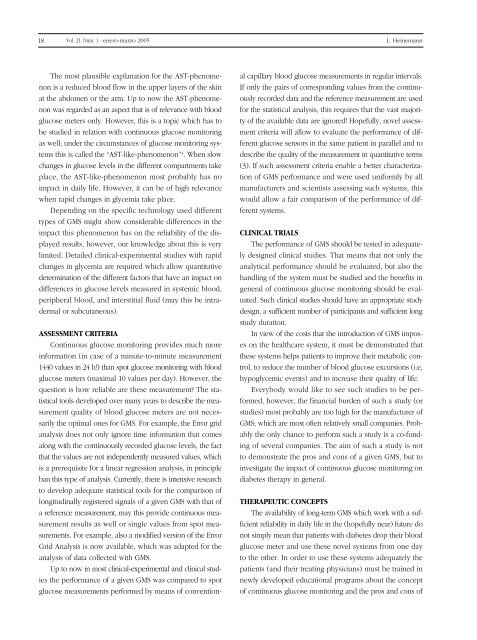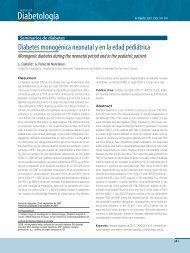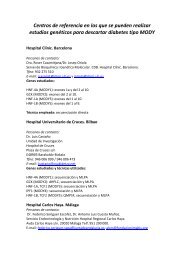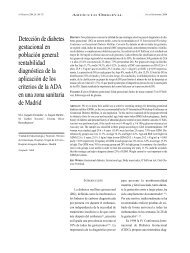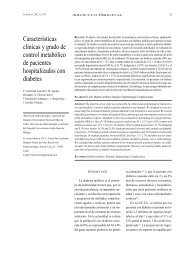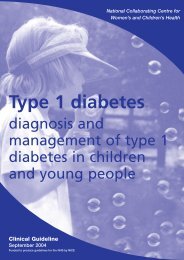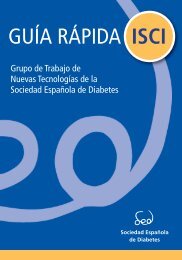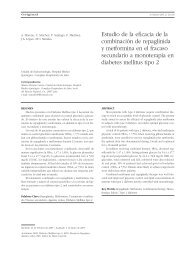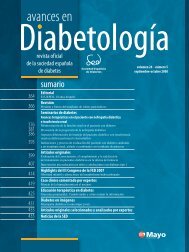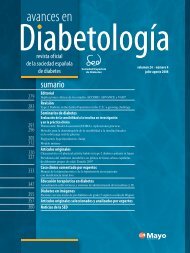Avances en DiabetologÃa - Sociedad Española de Diabetes
Avances en DiabetologÃa - Sociedad Española de Diabetes
Avances en DiabetologÃa - Sociedad Española de Diabetes
- No tags were found...
You also want an ePaper? Increase the reach of your titles
YUMPU automatically turns print PDFs into web optimized ePapers that Google loves.
18Vol. 21 Núm. 1 - <strong>en</strong>ero-marzo 2005L. HeinemannThe most plausible explanation for the AST-ph<strong>en</strong>om<strong>en</strong>onis a reduced blood flow in the upper layers of the skinat the abdom<strong>en</strong> or the arm. Up to now the AST-ph<strong>en</strong>om<strong>en</strong>onwas regar<strong>de</strong>d as an aspect that is of relevance with bloodglucose meters only. However, this is a topic which has tobe studied in relation with continuous glucose monitoringas well; un<strong>de</strong>r the circumstances of glucose monitoring systemsthis is called the “AST-like-ph<strong>en</strong>om<strong>en</strong>on” 4 . Wh<strong>en</strong> slowchanges in glucose levels in the differ<strong>en</strong>t compartm<strong>en</strong>ts takeplace, the AST-like-ph<strong>en</strong>om<strong>en</strong>on most probably has noimpact in daily life. However, it can be of high relevancewh<strong>en</strong> rapid changes in glycemia take place.Dep<strong>en</strong>ding on the specific technology used differ<strong>en</strong>ttypes of GMS might show consi<strong>de</strong>rable differ<strong>en</strong>ces in theimpact this ph<strong>en</strong>om<strong>en</strong>on has on the reliability of the displayedresults, however, our knowledge about this is verylimited. Detailed clinical-experim<strong>en</strong>tal studies with rapidchanges in glycemia are required which allow quantitative<strong>de</strong>termination of the differ<strong>en</strong>t factors that have an impact ondiffer<strong>en</strong>ces in glucose levels measured in systemic blood,peripheral blood, and interstitial fluid (may this be intra<strong>de</strong>rmalor subcutaneous).ASSESSMENT CRITERIAContinuous glucose monitoring provi<strong>de</strong>s much moreinformation (in case of a minute-to-minute measurem<strong>en</strong>t1440 values in 24 h!) than spot glucose monitoring with bloodglucose meters (maximal 10 values per day). However, thequestion is how reliable are these measurem<strong>en</strong>t? The statisticaltools <strong>de</strong>veloped over many years to <strong>de</strong>scribe the measurem<strong>en</strong>tquality of blood glucose meters are not necessarilythe optimal ones for GMS. For example, the Error gridanalysis does not only ignore time information that comesalong with the continuously recor<strong>de</strong>d glucose levels, the factthat the values are not in<strong>de</strong>p<strong>en</strong>d<strong>en</strong>tly measured values, whichis a prerequisite for a linear regression analysis, in principleban this type of analysis. Curr<strong>en</strong>tly, there is int<strong>en</strong>sive researchto <strong>de</strong>velop a<strong>de</strong>quate statistical tools for the comparison oflongitudinally registered signals of a giv<strong>en</strong> GMS with that ofa refer<strong>en</strong>ce measurem<strong>en</strong>t, may this provi<strong>de</strong> continuous measurem<strong>en</strong>tresults as well or single values from spot measurem<strong>en</strong>ts.For example, also a modified version of the ErrorGrid Analysis is now available, which was adapted for theanalysis of data collected with GMS.Up to now in most clinical-experim<strong>en</strong>tal and clinical studiesthe performance of a giv<strong>en</strong> GMS was compared to spotglucose measurem<strong>en</strong>ts performed by means of conv<strong>en</strong>tionalcapillary blood glucose measurem<strong>en</strong>ts in regular intervals.If only the pairs of corresponding values from the continuouslyrecor<strong>de</strong>d data and the refer<strong>en</strong>ce measurem<strong>en</strong>t are usedfor the statistical analysis, this requires that the vast majorityof the available data are ignored! Hopefully, novel assessm<strong>en</strong>tcriteria will allow to evaluate the performance of differ<strong>en</strong>tglucose s<strong>en</strong>sors in the same pati<strong>en</strong>t in parallel and to<strong>de</strong>scribe the quality of the measurem<strong>en</strong>t in quantitative terms(3). If such assessm<strong>en</strong>t criteria <strong>en</strong>able a better characterizationof GMS performance and were used uniformly by allmanufacturers and sci<strong>en</strong>tists assessing such systems, thiswould allow a fair comparison of the performance of differ<strong>en</strong>tsystems.CLINICAL TRIALSThe performance of GMS should be tested in a<strong>de</strong>quately<strong>de</strong>signed clinical studies. That means that not only theanalytical performance should be evaluated, but also thehandling of the system must be studied and the b<strong>en</strong>efits ing<strong>en</strong>eral of continuous glucose monitoring should be evaluated.Such clinical studies should have an appropriate study<strong>de</strong>sign, a suffici<strong>en</strong>t number of participants and suffici<strong>en</strong>t longstudy duration.In view of the costs that the introduction of GMS imposeson the healthcare system, it must be <strong>de</strong>monstrated thatthese systems helps pati<strong>en</strong>ts to improve their metabolic control,to reduce the number of blood glucose excursions (i.e,hypoglycemic ev<strong>en</strong>ts) and to increase their quality of life.Everybody would like to see such studies to be performed,however, the financial burd<strong>en</strong> of such a study (orstudies) most probably are too high for the manufacturer ofGMS; which are most oft<strong>en</strong> relatively small companies. Probablythe only chance to perform such a study is a co-fundingof several companies. The aim of such a study is notto <strong>de</strong>monstrate the pros and cons of a giv<strong>en</strong> GMS, but toinvestigate the impact of continuous glucose monitoring ondiabetes therapy in g<strong>en</strong>eral.THERAPEUTIC CONCEPTSThe availability of long-term GMS which work with a suffici<strong>en</strong>treliability in daily life in the (hopefully near) future donot simply mean that pati<strong>en</strong>ts with diabetes drop their bloodglucose meter and use these novel systems from one dayto the other. In or<strong>de</strong>r to use these systems a<strong>de</strong>quately thepati<strong>en</strong>ts (and their treating physicians) must be trained innewly <strong>de</strong>veloped educational programs about the conceptof continuous glucose monitoring and the pros and cons of


